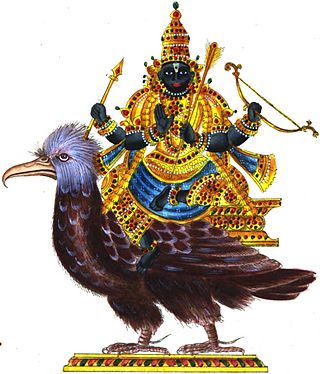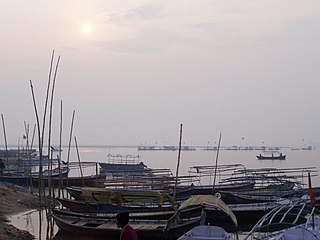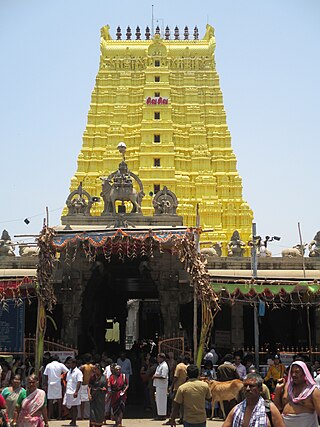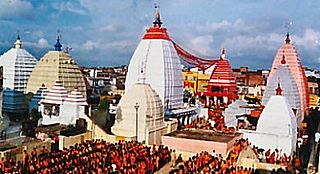
The Shri Trimbakeshwar Shiva Temple is an ancient Hindu temple in the town of Trimbak, in the Trimbakeshwar tehsil in the Nashik District of Maharashtra, India, 28 km from the city of Nashik and 40 km from Nashik road. It is dedicated to the Hindu god Shiva and is one of the twelve jyotirlingas where the Hindu genealogy registers at Trimbakeshwar, Maharashtra are kept. The origin of the sacred Godavari River is near Trimbak.

Yamunotri, also Jamnotri, is the source of the Yamuna River and the seat of the Goddess Yamuna in Hinduism. It is situated at an altitude of 3,293 metres (10,804 ft) in the Garhwal Himalayas and located approximately 150 kilometres (93 mi) North of Uttarkashi, the headquarters of the Uttarkashi district in the Garhwal Division of Uttarakhand, India. It is one of the four sites in India's Chota Char Dham pilgrimage. The sacred shrine of Yamunotri, source of the river Yamuna, is the westernmost shrine in the Garhwal Himalayas, perched atop a flank of the Bandarpunch mountain. The chief attraction at Yamunotri is the temple devoted to the Goddess Yamuna and the holy thermal springs at Janki Chatti which is 7 km away.

Omkareshwar is a Hindu temple dedicated to Shiva, located in Mandhata, nearby Khandwa city in Khandwa district of the Indian state of Madhya Pradesh. It is one of the 12 revered Jyotirlinga shrines of Shiva. It is on an island called Mandhata, near Khandwa city in the Narmada River at Khandwa district in Madhya Pradesh, India; the shape of the island is said to be like the Devanagari ॐ symbol.

Kashi Vishwanath Temple is a Hindu temple dedicated to Shiva. It is located in Vishwanath Gali, in Varanasi, Uttar Pradesh, India. The temple is a Hindu pilgrimage site and is one of the twelve Jyotirlinga shrines. The presiding deity is known by the names Vishwanath and Vishweshwara, literally meaning Lord of the Universe.

Muktinath is a Vishnu temple, sacred to both Hindus and Buddhists, located in the Muktinath Valley at the foot of the Thorong La mountain pass in Mustang, Nepal. It is one of the world's highest temples. In Hinduism, it is one of the 108 Divya Desams and the only Divya Desam located outside India. But Muktinath was considered a temple of the purely Buddhist deity Avalokiteshvara until the middle of the eighteenth century. After Jumli Raja occupied Mustang's Thini, he encroached on the same Buddhist shrine and worshiped his idol. After King Malebamba sat on the throne of Parbat, Jumla was taken with his help and it was again considered as the temple of Avalokiteshvara. Muktinath was finally Hinduized after Bahadur Shah even waved Mustang. It is also known as Mukti Kshetra, which literally means the 'liberation arena' (moksha) and is one of the Char Dham in Nepal.
Prabhas Patan, historically named Dev Patan, is locality in Veraval, Gujarat. As the site of the Somnath temple and its associated Jyotirlinga, it is an important place of Hindu pilgrimage.

Shani, or Shanaishchara, is the divine personification of the planet Saturn in Hinduism, and is one of the nine heavenly objects (Navagraha) in Hindu astrology. Shani is also a male Hindu deity in the Puranas, whose iconography consists of a figure with a dark complexion carrying a sword or danda (sceptre) and sitting on a crow. He is the god of karma, justice, and retribution, and delivers results depending upon one's thoughts, speech, and deeds. Shani is the controller of longevity, misery, sorrow, old age, discipline, restriction, responsibility, delays, ambition, leadership, authority, humility, integrity, and wisdom born of experience. He also signifies spiritual asceticism, penance, discipline, and conscientious work. He is associated with two consorts: Neela, the personification of the gemstone sapphire, and Manda, a gandharva princess.

In Hindu tradition, Triveni Sangam is the confluence of three rivers that is also a sacred place, with a bath here said to flush away all of one's sins and free one from the cycle of rebirth.

Badarinath or Badarinarayana Temple is a Hindu temple dedicated to Vishnu. It is situated in the town of Badrinath in Uttarakhand, India. The temple is also one of the 108 Divya Desams dedicated to Vishnu—holy shrines for Vaishnavas—who is worshipped as Badrinath. It is open for six months every year, because of extreme weather conditions in the Himalayan region. The temple is located in Garhwal hill tracks in Chamoli district along the banks of Alaknanda River. It is one of the most visited pilgrimage centers of India, having recorded 2.8 million visits in just 2 months in 2022. It is one of the Char Dham pilgrimage sites.

Kedarnath Temple is a Hindu temple, one of the twelve jyotirlinga of Shiva. The temple is located on the Garhwal Himalayan range near the Mandakini river, in the state of Uttarakhand, India. Due to extreme weather conditions, the temple is open to the general public only between the months of April and November. During the winters, the vigraha (deity) of the temple is carried down to Ukhimath to be worshipped for the next six months. Kedarnath is seen as a homogeneous form of Shiva, the 'Lord of Kedarkhand', the historical name of the region.

Ramanathaswamy Temple is a Hindu temple dedicated to the Hindu god Shiva located on Rameswaram island in the state of Tamil Nadu, India. It is also one of the twelve Jyotirlinga temples. It is one of the 275 Paadal Petra Sthalams, where Nayanars, Appar, Sundarar and Tirugnana Sambandar, have glorified the temple with their songs. The Lingam of Ramanathaswamy (Shiva), was established and worshiped by Shri Rama, before he crossed his bridge to the present-day island of Sri Lanka. It is one of the Char Dham pilgrimage sites. The temple was expanded during the 12th century by the Pandya Dynasty, and its principal shrine’s sanctum was renovated by Jeyaveera Cinkaiariyan and his successor Gunaveera Cinkaiariyan, monarchs of the Jaffna kingdom. The temple has the longest corridor among all Hindu temples in India. It was built by King Muthuramalinga Sethupathiy. The temple, located in Rameswaram, is considered a holy pilgrimage site for Shaivites, Vaishnavites and Smarthas.

Baidyanath Temple, also known as Baba Baidyanath Dham, is a Hindu temple dedicated to Shiva. It is located in Deoghar, in the Santhal Parganas division of the Indian state of Jharkhand. The temple complex comprises the central shrine of Baba Baidyanath along with 21 additional temples. It is significant to the Hindu sects of Shaivism as this temple is referred to as one of the twelve Jyotirlingas.
Jageshwar is a Hindu pilgrimage town near Almora in Almora district of the Himalayan Indian state of Uttarakhand. It is one of the Dhams in the Shaivism tradition. The site is protected under Indian laws, and managed by the Archaeological Survey of India (ASI). It includes Dandeshwar Temple, Chandi-ka-Temple, Jageshwar Temple, Kuber Temple, Mritunjaya Temple, Nanda Devi or Nau Durga, Nava-grah temple, a Pyramidal shrine, and Surya Temple. The site celebrates the Jageshwar Monsoon Festival during the Hindu calendar month of Shravan and the annual Maha Shivratri Mela, which takes place in early spring.

In Hinduism, the yatra (pilgrimage) to the tirthas has special significance for earning the punya needed to attain the moksha (salvation) by performing the darśana, the parikrama (circumambulation), the yajna, the Dhyana, the puja (worship), the prarthana, the dakshina, the seva, the bhandara, etc. These sacred places are usually located on the banks of sacred waters, such as sacred rivers or their tributaries, the kundas, the ghats, or the stepwells, or the temple tanks.
Sacred describes something that is dedicated or set apart for the service or worship of a deity; is considered worthy of spiritual respect or devotion; or inspires awe or reverence among believers. The property is often ascribed to objects, or places.

Yatra, in Indian-origin religions, Hinduism, Buddhism, Jainism and Sikhism, generally means a pilgrimage to holy places such as confluences of sacred rivers, sacred mountains, places associated with Hindu epics such as the Mahabharata and Ramayana, and other sacred pilgrimage sites. Visiting a sacred place is believed by the pilgrim to purify the self and bring one closer to the divine. The journey itself is as important as the destination, and the hardships of travel serve as an act of devotion in themselves.

The Char Dham, also rendered the Chatur Dhama is a set of four Hindu pilgrimage sites in India, consisting of Badrinath, Dwarka, Puri and Rameswaram. Badrinath, Dwarka, and Puri are shrines of Vishnu, whereas Rameswaram is a shrine of Shiva.

Panch Kedar, rendered Pancha Kedara in Sanskrit, refers to five Hindu temples or holy places of the Shaivite sect dedicated to god Shiva. They are located in the Garhwal Himalayan region in Uttarakhand, India. They are the subject of many legends that directly link their creation to Pandavas, the heroes of the Indian epic Mahabharata.
In religion and spirituality, a pilgrimage is a very long journey or search of great moral significance. Sometimes, it is a journey to a sacred area or shrine of importance to innate faith. Members of every major religion participate in pilgrimages. A person who makes such a journey is called a pilgrim.

Hinduism is the dominant religion practised in the state of Assam. According to some scholars, it is home to some of the most complex and poorly understood traditions in Hinduism. People follow traditions belonging to Shaivism, Shaktism, Tantra, and an indigenous form of Vaishnavism called Ekasarana Dharma; taken together the practitioners constitute around 61% of the state population as per the 2011 Census. Hindus form a majority in 17 out of the 29 districts of Assam. By region, there is a significant diversity among the ethnic groups that profess the Hindu faith, traditions, and customs. As per as 2011 Census, In Brahmaputra valley of Assam, Hindus constitute 62% of the population, the majority being ethnic Assamese. In the autonomous Bodoland region of Assam, Hindus constitute 71.3% of the region's population, most being of the Bodo tribe. In the Barak valley region of southern Assam, Hindus constitute 50% of the region's population, most being ethnic Bengalis. The Hill Tribes of Assam, particularly the Karbi people of Karbi Anglong and Dimasa people of Dima Hasao, are mainly Animism.


















